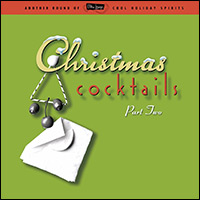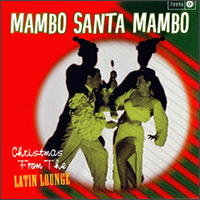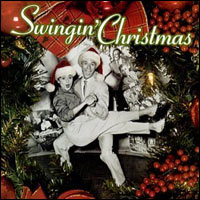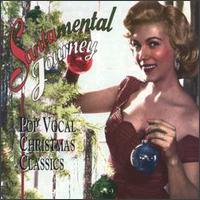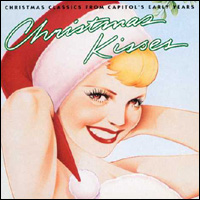
Croon & Swoon
various artists
Support www.hipchristmas.com! ![]() Shop at
Amazon,
Apple Music, and more...
Shop at
Amazon,
Apple Music, and more...
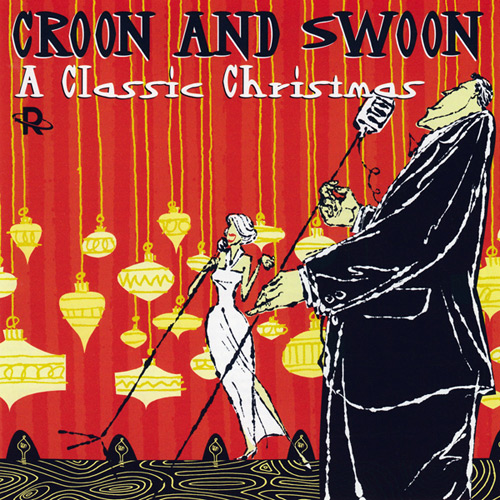 Lounge music, swing, and easy listening experienced quite a revival in the early 1990's - arguably in reaction to the sudden dominance of loud, noisy, alternative rock music. The movement gave us new outfits like Combustible Edison, Royal Crown Review, and Squirrel Nut Zippers, spurred a consumer frenzy for all things swank, and inspired at least one great movie - Swingers (1996). But, more apropos to our discussion, the lounge revival spawned a new appreciation for all sorts of vintage pop music outside the realm of rock - and a boatload of reissues to cash in on the craze.
Lounge music, swing, and easy listening experienced quite a revival in the early 1990's - arguably in reaction to the sudden dominance of loud, noisy, alternative rock music. The movement gave us new outfits like Combustible Edison, Royal Crown Review, and Squirrel Nut Zippers, spurred a consumer frenzy for all things swank, and inspired at least one great movie - Swingers (1996). But, more apropos to our discussion, the lounge revival spawned a new appreciation for all sorts of vintage pop music outside the realm of rock - and a boatload of reissues to cash in on the craze.
These were usually marketed with buzz words like exotica, space age, cocktail, and bachelor pad, but the term "crooner" got bandied about quite a bit, as well. Suddenly, crooners were cool again, and not just fodder for comedians like Bill Murray and Andy Kaufman. It was too late to help Frank Sinatra and Dean Martin - both of whom had retired by then, and both of whom would be dead by the end of the decade. But, Tony Bennett got a huge boost out of it, and latter-day crooners like Michael Bublé owe their careers to it. And, in addition to fine lounge collections like Christmas Cocktails, Mambo Santa Mambo, and Swingin' Christmas, we got Croon And Swoon: A Classic Christmas (1998) and Croon And Swoon: A Classic Christmas, Volume Two (1999).
The Croon And Swoon series was released by Repeat, a short-lived reissue imprint of Relativity Records, who were known mostly for their rap and heavy metal rosters. From a cynical perspective, Croon And Swoon was a fairly crass attempt to cash in on the lounge craze - and tardy, the dust having largely settled on the fad by then. But, taken on their own terms, these discs are pretty damn great, thanks in no small part to their purity of vision: all acknowledged classics by the most celebrated vocalists of the post-war era - and no johnny-come-lately revivalists. Roughly half of the music comes from the vaults of Sony, which was already part owner of Relativity by 1998 and would eventually swallow the company whole. At the time, Sony controlled only the catalogs of Columbia and their associated labels. But, Repeat licensed tracks from all the other major labels, so we get a pretty balanced look at the subject matter.
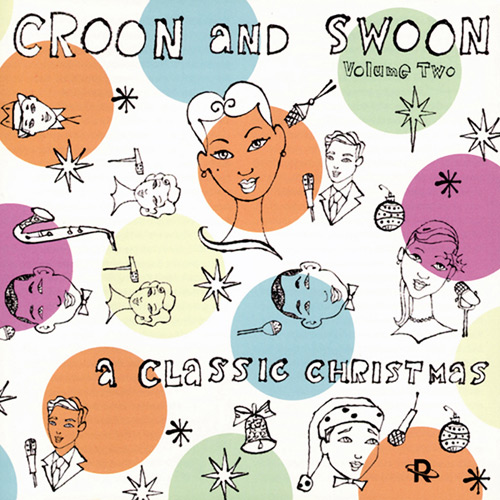 Not As Easy As It Looks
Not As Easy As It Looks
You see, there was a time when this music wasn't "easy listening" - it was popular music - and the songs on Croon And Swoon come primarily from the years before rock 'n' roll rendered the form (at least temporarily) irrelevant. Together, the two Croon And Swoon volumes collect 36 songs recorded from 1942 to 1974, and most of them were big hits by big stars - including a number of arguably definitive renditions of Christmas standards. For the enthusiast, Croon And Swoon is a good introduction to classic holiday pop, and for the dabbler it's a one-stop shop.
That said, if you were raised on rock 'n' roll or rhythm 'n' blues or any of their offshoots - and I was - much of the music on Croon And Swoon will listen very easy, indeed. Hipsters like us can only wring so much enjoyment from performers like Ray Conniff, Johnny Mathis, and Julie Andrews. Moreover, these songs don't rock, they don't roll, only a couple of them twang, and to the extent that they swing, they swing lightly. In a word, they are not hip. On the other hand, if you own a lot of this type of music - and I do - you will find the Croon And Swoon series largely redundant. Personally, when I bought them, my eyes were opened to a world of music largely outside my experience. Decades later, only a few of the tracks can't be found elsewhere in my collection.
The first volume of Croon And Swoon is the better of the two, largely because the label front-loaded it with a number of recognized classic debut performances such as Judy Garland's "Have Yourself A Merry Little Christmas" (1944), Gene Autry's "Rudolph The Red-Nosed Reindeer" (1949), and Andy William's "It's the Most Wonderful Time of the Year" (1963). Other tracks, such as Tony Bennett's "My Favorite Things," Peggy Lee's "Christmas Waltz," Leroy Anderson's "Sleigh Ride," and Rosemary Clooney's "White Christmas" - recorded the same year she starred in the movie of the same name - rank right up there with the best of them. Even Perry Como - a polarizing figure, for sure - gets a spotlight with the one Christmas song he really owns, his 1954 premiere of "There's No Place Like Home For The Holidays."
Wake Me When It's Over
The less impressive second volume of Croon And Swoon also captures several defining moments in the history of Christmas music, including Bing Crosby's "Happy Holiday" (1942), the Andrews Sisters' "Christmas Island" (1946), Eartha Kitt's "Santa Baby" (1953), and Brook Benton's "This Time Of The Year" (1959) - the closest thing to soul music on either volume. Other highlights include one of Louis Armstrong's celebrated Decca singles ("Winter Wonderland") and one of Mel Tormé's several recordings of "The Christmas Song," his 1945 composition with frequent collaborator Robert Wells. Of course, that song was made famous in 1946 by Nat King Cole - who is otherwise conspicuously absent, by the way.
The rest of Croon And Swoon, Volume 2 consists of crooners crooning, basically. Same old singers, same old songs. It's all fine and good, if that's what you're into, but I nod off after a while. The performances are uniformly admirable - I'm not about to throw stones at Mahalia Jackson - but I was most impressed by Lena Horne's slow burn on "What Are You Doing New Year's Eve?" and Jerry Vale's smooth-as-silk reading of "Blue Christmas" - a song usually cast in the mold set by Ernest Tubb or Elvis Presley.
When you listen to a lot of Christmas music - as I obviously do - familiarity breeds contempt. At this stage of the game, not even Mahalia Jackson can make "The First Noël" interesting. So, to my surprise, I also picked two songs by Doris Day, a singer who could make Perry Como seem wild and abandoned by comparision. Both songs are from her 1964 Christmas album, and they stand out, both on that record and on Croon And Swoon, because neither song gets covered that often. "Toyland" is from a turn-of-the century musical, and Day's performance is surprisingly melancholy for a song addressed at children. "Snowfall" is a beguiling song written by jazz bandleader Claude Thornhill in 1941, with lyrics later added by his wife, and it suits Day's delicate vibrato to a tee.
Consumer Notes
The Croon And Swoon series was produced by Paul Williams, who I can only assume is not the famous songwriter. The mastering is quite good, though some of the older, mono tracks will sound a bit rough to modern ears. It's worth noting that four titles are repeated across the two volumes of the Croon And Swoon series. For instance, you get two versions of "Silver Bells," one by Ray Conniff on the first volume and another by Perry Como on the second. It's not a fatal flaw, but it strikes me as kind of lazy, Mr. Williams. Both volumes are attractively packaged, but they include no pictures of the distinguished artists. Both volumes include track annotation, though the second volume slacks off a bit, and both include entertaining liner notes by two more people I haven't heard of.
As wide ranging as the Croon And Swoon series is, it's worth noting what's missing, and that's primarily a variety of important Christmas crooners that didn't record for Columbia. As noted, this includes Nat King Cole as well as Rat Pack members Frank Sinatra and Dean Martin, Jo Stafford, Jack Jones, Al Martino, Patti Page, and the McGuire Sisters - to name a few obvious omissions. And, I'm sure Bobby Darin would object to being left out. He always had a chip on his shoulder. Country crooners Eddy Arnold and Jim Reeves are also missed - especially considering that Gene Autry, who's represented on both volumes, isn't really a crooner. And, finally, Leroy Anderson's "Sleigh Ride" is a genuinely oddball selection for Croon And Swoon. It's a classic for sure, but it's an instrumental on an album dedicated to singers. Seems like a no-brainer...
The Croon And Swoon series was released only on compact disc at the height of the CD era. Like most cross-licensed compact discs, they've never made the leap into the world of downloads and streaming, but most of the songs can be found on other sources.
 Albums
Albums
 Essential Songs
Essential Songs
- Blue Christmas (Jerry Vale, 1964)
- Christmas Island (Andrews Sisters, 1946)
- The Christmas Song (Chestnuts Roasting On An Open Fire) (Mel Tormé, 1966)
- The Christmas Waltz (Peggy Lee, 1960)
- Frosty The Snowman (Gene Autry, 1950)
- Happy Holiday (Bing Crosby, 1942)
- Have Yourself A Merry Little Christmas (Judy Garland, 1944)
- Have Yourself A Merry Little Christmas (Margaret Whiting, 1949)
- Here Comes Santa Claus (Doris Day, 1949)
- I'll Be Home For Christmas (Perry Como, 1946)
- It's Beginning To Look A Lot Like Christmas (Bing Crosby, 1951)
- It's The Most Wonderful Time Of The Year (Andy Williams, 1963)
- Let It Snow! Let It Snow! Let It Snow! (Lena Horne, 1966)
- My Favorite Things (Tony Bennett, 1968)
- Rudolph The Red-Nosed Reindeer (Gene Autry, 1949)
- Santa Baby (Eartha Kitt, 1953)
- Santa Claus Is Coming To Town (Bing Crosby & The Andrews Sisters, 1943)
- Sleigh Ride (Leroy Anderson, 1950)
- Snowfall (Doris Day, 1964)
- (There's No Place Like) Home For The Holidays (Perry Como, 1954)
- This Time Of The Year (Brook Benton, 1959)
- Toyland (Doris Day, 1964)
- We Need A Little Christmas (from Mame) (Angela Lansbury, 1966)
- What Are You Doing New Year's Eve? (Lena Horne, 1966)
- White Christmas (Rosemary Clooney, 1954)
- Winter Wonderland (Louis Armstrong, 1952)
 Further Listening
Further Listening
- Christmas Kisses: Christmas Classics From Capitol's Early Years (various artists, 1990)
- The Christmas Music Of Johnny Mathis: A Personal Collection (Johnny Mathis, 1993)
- Mambo Santa Mambo: Christmas From The Latin Lounge (various artists, 2000)
- Merry Xmas From The Space-Age Bachelor Pad (Esquivel, 1996)
- Santamental Journey: Pop Vocal Christmas Classics (various artists, 1995)
- Snowfall: The Tony Bennett Christmas Album (1968)
- Swingin' Christmas (various artists, 1999)
- Ultra-Lounge Christmas Cocktails (various artists, 1996)
- The Voice Of Christmas (Bing Crosby, 1998)
- With A Christmas Vibe (Arthur Lyman, 1996)




